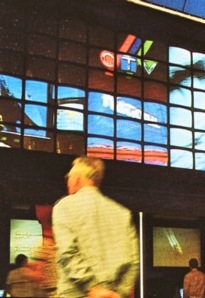Tuesday, April 29, 1986.
IT'S NOT FAIR. FILM is the glamour medium — it gets all the praise and all the attention.
Well, what about video, Expo's poor, square-screen workhorse?
There are TV monitors everywhere on the fair site, but do they get to have any fun?
They do if they're in the Canadian Pacific Pavilion's Theatre One. Indeed, the term "TV head" takes on new meaning in environmental designer Leonard Levitan's 20-minute visit with Father Time.
Influenced, perhaps, by robot variety shows like Disneyland's Country Bear Jamboree, Levitan has created a room in which the front and side walls are made up of individual shadow-boxed tableaux, each containing one or two life-sized figures. As Time's voice muses on the troubles he's seen, the boxes light up and reveal that their 22 different figures are fitted with "talking head" video monitors.
Levitan's untitled show is a sharp, tongue-in-cheek examination of the effect of transportation technology on human attitudes. Included among the cross-talkers are a pair of bellicose cavemen, a selection of "new" Canadians, Sir John A. Macdonald, CPR-builder William Van Horne and a fully animated donkey named Craigellachie.
A different kind of electronic playfulness is demonstrated on the Canada Pavilion's Vidiwall, a viewing surface made up of 108 monitors stacked six high and 18 wide.
A closed-circuit system served by 14 laser-disc players, the wall features a continuously shifting multi-screen show. Computer controlled, it can display its images on separate monitors, enlarged over several screen blocks or as a single, wall-filling picture.
Conspicuous by its absence at Expo 86 is the new generation of High Definition Television monitors currently [1986] under development in Europe and Japan. Boasting image resolution comparable to film, HDTV is a communications advance not yet included in the special-venue display designers' repertoire.
All video operations at Expo 86 conform to the North American 525-line standard.
The above is a restored version of a Province Expo 86 preview feature by Michael Walsh originally published in 1986. For additional information on this archived material, please visit my FAQ.
Afterword: Thirty years ago, the cathode ray tube (CRT) ruled. Although flat video screens were popular in science fiction movies — a bit of set decoration that signified "the future" — the reality was the big box that sat in our living rooms. In the 50 years between 1946 and 1996, the size of the screens available grew from 12 to about 45 inches, with colour sets introduced in 1953. During that time, image resolution was measured in scan lines, with the North American broadcast standard (NTSC) set at 525. (The Europeans, who had adopted the 625-line PAL standard, enjoyed a somewhat sharper picture.) At the time of Expo 86, HDTV was the much talked-about (if little seen) next step in television technology.
Given that the Vancouver fair had a dual theme — World in Motion (Transportation) - World in Touch (Communications) — I'd expected to see more of the revolution occurring in communications technology. As it happened, 1986 was the year that the U.S. and Europe vetoed Japan's proposal to make its HDTV technology the worldwide standard. Change was, of course, inevitable. Exactly 20 years ago, everyone felt the earth shifting beneath the broadcast world. In 1996, Japan's Sony and Sharp Corporations entered into a joint venture to mass produce flat, wide-screen televisions. That was also the year that the U.S. Congress passed a Telecommunications Act that mandated the transition from analog to digital broadcasting, a switchover that finally came to pass in mid-2009. The availability of larger, wider television screens worked to increase the demand for HD, and the U.S. saw its first commercial HD broadcasting in 1998.
Nor did our world exposition's futurists prepare us for British computer scientist Tim Berners-Lee's 1989 invention, the World Wide Web. They also might have foreseen the 1996 introduction of personal data assistants (PDAs, aka the smartphone) or the 1998 creation of the Internet search engine Google. I could go on, but you get the idea. Though Expo's films were one hell of show, video was the untold story of the future to come.
See also: The 13 articles included in this, the first of four Expo 86 special reports, are:
